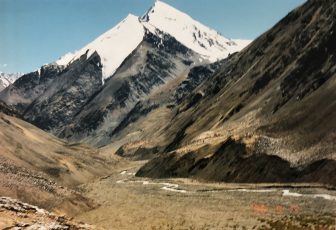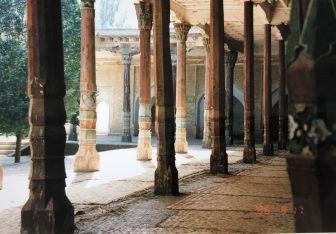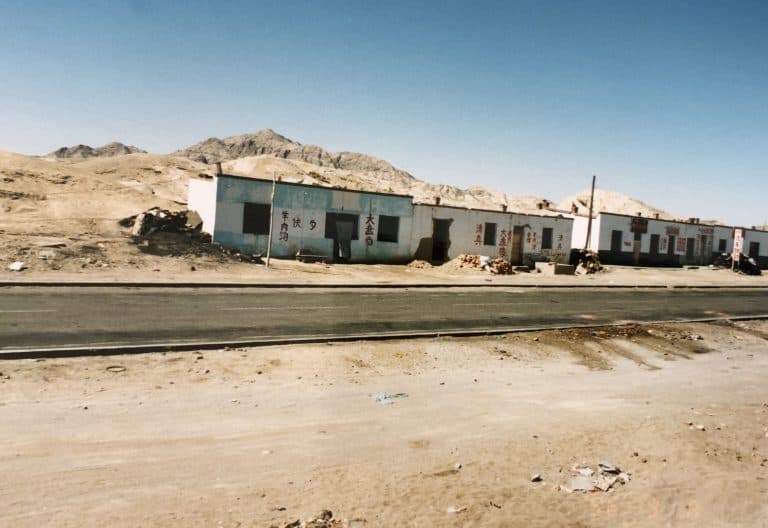
[ Sept.1996 ] At the beginning of the third week of our grand across China travel, we headed west for Hami from Dunhuang by bus.
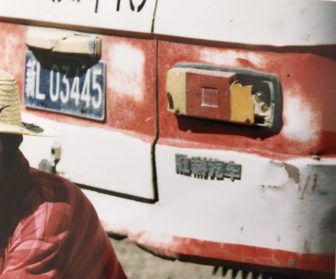
The bus was as battered as the one to Xiahe.
The fare was 64.8 yuan ($1=8.28 yuan in those days).
The straight road in the vast desert was properly paved, but for some reason the bus bumped a lot and the speed was as slow as 40 km/h.
On top of that, on the way, the driver tied a broken minibus and pulled it.
And the rope came loose many times and each time the bus stopped for about 15 minutes to tie up again.
While our bus was struggling, the secondhand Japanese buses carrying tour groups overtook us.
I saw quite a few Sagawa Express (Japanese door to door delivery company) trucks, but I guessed that it was not that Sagawa expanded its business in China, but they gave their old trucks to China.
Not only them, but sometimes I saw luxurious cars such as Mercedes or good RVs overtook our beat-up bus.

Why do the buses for ordinary people have to be so rickety?
We stopped for the lunch break at the unknown place where only 4-5 shacks operating as restaurants were standing by the road in the desert.
Two women working on chili pepper spread on the ground and by them a woman was washing something using a washboard.
She was taking the water from a drum.
The water must be precious here.
After all, this bus journey took 10 hours.
It was very cold at first half and very hot at the second half and because I was holding it, it was a very hard journey for me.
On top of that, the view was so monotonous and boring.
At one point, I saw a white line far away which looked like clouds and gradually I realised that it was a mountain range with snow.
After that I slept for a while, but when I woke up, the view was the same and only the mountain range was nearer.
In the end, the bus passed the mountains seeing it on the right hand side.
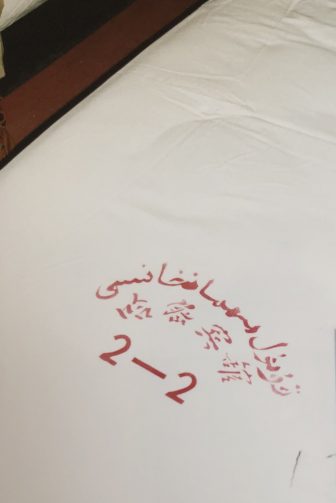
That was the only ‘event’ I saw through the window and the rest was all desert.
We hear the expression ‘Green Earth’, but in fact, the main feature of the earth is this kind of tough desert.
Finally we arrived in Hami.
First, we bought the bus ticket for the next day.
We got stressed out because the local people cut in the queue without a trace of shame.
Up here, we see many signs written in both Chinese and Uighur languages and the people’s face looked more Western.
Hami was a quite large city and we stayed one night in the 168 yuan room in Hami Hotel.
The room was shabby with the problematic bathroom as usual and the hotel restaurant was bleak like the one in the former Soviet Union, but the people working there were nice and friendly which was a saving grace.
Next morning, we got on a bus again.
This time, as soon as we got on it, I felt we entered the Uighur world.
The people sat in front of us were different from Han Chinese.
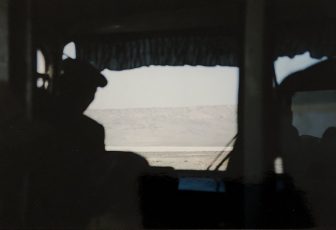
The short hair girl looked like a Japanese pop singer Hiromi Go and her grandmother looked similar to a Turkish woman I had met in Turkey.
The woman who came to see them off looked like a Japaneses actress Keiko Kishi and his son looked half Western.
The girl’s grandfather had even blue eyes.
During this long journey, they gave us a bunch of grapes.
I ate them like they did, without peeling the skin, and got very surprised at the strong taste of them.
The view from the window on the day was a bit better than the day before with the slightly green ground stretched towards the reddish rocky mountains and behind them there were higher purple mountains.
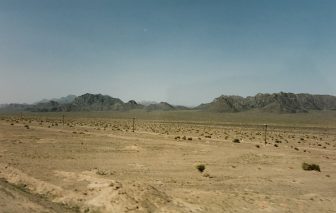
After that, the unfriendly desert came back, but after the sign “68 km to Turpan”, the view became more dramatic.
It was more like a scene in cowboy films.
Not only the mountains rose, but also beneath the road the earth was split.
Later I found out that it was not far from Besecurik Thousand Buddha Cave.
On the right hand side, we could see the famous Flaming Mountains, though they were not so red maybe because of the timing.
After 9 hours, at last we were in Turpan.


